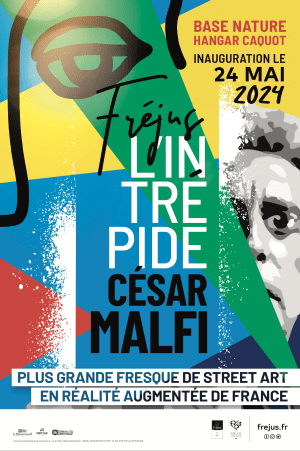Description
Of Italian Renaissance inspiration, there are 2 Palladian villas (in reference to the Venetian architect Andrea Palladio) in France including Villa Aurélienne in Fréjus. Built at the end of the 19th century, it takes its name from the Roman Via Aurelia, whose route is nearby. The Villa overlooks a huge wooded park and delights in the heterogeneity of its influences (ancient, classical, oriental). A holiday residence originally, it now lends itself to the excitement of summer cultural festivities.
Contact details
Villa Aurélienne
85 Avenue du Général d'Armées Jean Calliès, 83600 Fréjus
Ticket office
Share
Favourite
- Neolclasic façade
- Marble fireplaces
- Remains of the aqueduct
- Huge stairway decorated with statues
Practical info
Opening times
Opening hours of the park: • winter: 9 am – 5pm (weekdays) 9 am -12 pm and 2 pm – 6 pm (week-ends) • summer 9 am – 7 pm (weekdays) 9 am – 12 pm and 2pm – 7 pm (week-ends)
Villa Aurélienne is open during the exhibition period from 2 pm to 5 pm (closed on Tuesdays)
Villa Aurélienne: history
WHO BUILT VILLA AURELIENNE?
Consulting the first register of the cadastral plan of Fréjus, (C443), a certain Mr James Crossman built a villa in the district of “Raton”. Construction completed in 1889, it was Chateau Aurélien. Two inscriptions engraved on the small bridge located below the villa provide additional information:
J.H.C./A.D./1889
“J.H.C” would be the initials of the owner (JH Crossman) and “AD” for Anno Domini”;
On the other side of the bridge, there is another inscription “IN CRUCE SPES MEA”, motto meaning, “In this cross I place my hope”. In an armorial published in England in 1889, this motto was shown as that of Sir William Crossman, who had a brother, James Hiscutt Crossman, who was authorized to use his coat of arms and motto. It is he who built the villa, called “Château Aurélien” at the time. Heir to a wealthy London brewer, the “Mann, Crossman & Paulin Ltd” brewery was then one of the most important in England.
In 1889 he had the idea of building this castle on the Côte d’Azur. Château Aurélien is a prestigious building designed by the architect Henri Lacreusette, born in Marseille, to whom we also owe the Grands Louvans and La Cigale villas in Saint-Aygulf, as well as the Saint-Aygulf Chapel and many other villas in Saint-Raphaël, Sainte-Maxime etc.
With its 79 taxable openings indicated on the cadastre, it was undoubtedly the largest villa in Fréjus-Saint-Raphaël.
James Hiscutt Crossman kept borrowing and soon had to put the Chateau up for sale. It was bought by Madame Lepel-Cointet in 1892, widow of Marc Lepel-Cointet, a stockbroker in Paris, son of a collector of paintings and works of art whose collection he had added to.
Madame Lepel-Cointet who led the life of a socialite, hosted the upper crust of Paris on the Côte d’Azur, including André Gide in 1897. She also lived well beyond her means and had to sell the villa in 1905. It was bought by Henri Félix Gourio de Refuge, who inherited the title of Marquis in 1901, on the death of his father.
On 8 July 1913, under the heading of legal publications, Le Figaro published the announcement of the public auction by court order of Château Aurélien. The sale took place on 7 August 1913, and was bought by Charles de Cambefort. He was a banker in Paris, married to Suzanne de Witt. The Chateau was renamed “Villa Aurélienne”. Charles died in 1919 and on the death of his wife in 1934, the Villa went to their two daughters, Germaine and Henriette, who was married to Pierre Schweisguth, a banker. In 1932 their daughter married Maurice Couve de Murville who was Minister of Foreign Affairs, Economy and Finance, Prime Minister, MP and Senator. The Villa became the sole property of Henriette in 1940.
There are only two Palladian-style villas in France, Villa Aurelienne and Chateau de Syam in the Jura. The facade is reminiscent of the Palazzo Chiericati built by Andrea Palladio which is an urban Renaissance residence in Veneto. Palladio -1508 – 1580, great Italian Renaissance architect was also the author of a treatise entitled, “The four books of architecture.”
In Villa Aurélienne, the Palladian influence is everywhere, even on the front façade, with the pattern of arched and rectangular bays, called serlian windows, as well as on the ground floor and the upper floor which are organized around a peristyle courtyard covered with a glass roof typical of Renaissance architecture. The reception rooms, including the sitting room with alcove, are on the south side opening onto the terrace and the garden.
A sumptuous residence, it is adorned with prestigious materials: black marble floors, fruit wood marquetry, moldings and marble fireplaces, a large central staircase… The offices are relegated to the north and the basement, as are the servants’ rooms.
In addition to its 1700 m2 of living space, it has a 24-hectare park where you can still see the balustrades on the promontories, bridges and water mirror, as well as three small oriental inspired buildings.
In 1988, the property and its park belonged to the town of Fréjus where there are also remains of the Roman aqueduct dating from the 1st century AD, completing the protection of the park as a natural site (in 1964 and 1966).
The villa and its park have been listed on the supplementary inventory of historical monuments since 1989.
Renovated in 1994, the stained glass windows are the work of glass master Ducatez of Salerno. Villa Aurélienne is now used for official receptions and cultural venue where many temporary exhibitions and cultural events are held.






